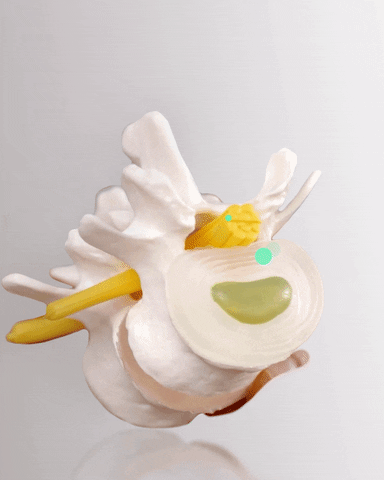- Field Guide to Back and Neck Pain
- Posts
- Degenerative Disc Disease
Degenerative Disc Disease

Age-related, Wear-and-Tear of the Spine

Good Morning! This is The Field Guide to Back and Neck Pain, the newsletter to stay up to date on treatments and symptoms of back pain, neck pain and other chronic pain conditions. Welcome to all new readers! To those that have been here before, thank you, it’s so good to see you again.
Here is what you can expect from today’s edition:
Degenerative Disc Disease explained
How to manage and treat Degenerative Disc Disease
News: Keeping a positive attitude about aging
Degenerative Disc Disease explained
Degenerative disc disease (DDD) is a condition that affects the spine, particularly the intervertebral discs—the soft, rubbery cushions located between the vertebrae (bones) of the spine. Despite its name, DDD is not technically a disease but rather a natural part of the aging process that occurs in the spine.
As people age, the intervertebral discs naturally lose water content and become thinner and less flexible. This process is known as disc degeneration. DDD can occur in any part of the spine, but it commonly affects the lumbar (lower back) and cervical (neck) regions.
Below is a comparison of a healthy spine and a spine with disc degeneration:
Let’s review some of they key features of Degenerative Disc Disease:
Disc Degeneration: The intervertebral discs lose their ability to absorb shock and provide flexibility due to reduced water content and structural changes.
Pain and Discomfort: As the discs degenerate, it can lead to chronic pain, stiffness, and discomfort in the affected area of the spine. The pain may radiate to other parts of the body, depending on the location of the affected discs.
Limited Mobility: The loss of flexibility and shock-absorbing capabilities of the discs can limit spinal mobility and range of motion, making certain movements or activities more challenging and painful.
Who is at risk for developing Degenerative Disc Disease?
Common risk factors for developing degenerative disc disease include aging, genetics, smoking, obesity, physically demanding jobs, injury, and poor posture.
Keep reading to learn about some of the ways to manage Degenerative Disc Disease!
Don’t Quote Me On This…
"Through the persistence of pain, we uncover our resilience, our capacity to endure, and the strength to embrace life's challenges with grace. In the face of adversity, we find the courage to rise, knowing that every day we endure is a testament to our unwavering spirit and determination. Pain may be a part of our journey, but so is the power to triumph over it and flourish in the light of hope."
How to Manage and Treat Degenerative Disc Disease
Treatment for degenerative disc disease often focuses on managing symptoms and improving quality of life. This can involve a combination of non-surgical approaches such as physical therapy, exercise, pain management, lifestyle modifications, and medication. In some severe or advanced cases, surgery may be considered to alleviate pain or correct structural issues associated with DDD, such as spinal fusion or artificial disc replacement.
Let’s review some examples of each type of treatment:
Exercise: core strengthening, flexibility and range-of-motion exercises and low impact aerobic exercises like walking, swimming, or cycling.
Lifestyle Modifications: maintain a healthy weight, practice proper posture and avoid heavy lifting
Medications: over-the-counter pain medications like like ibuprofen or acetaminophen, prescription medications and topical pain medications
Pain Management: epidural steroid injections, disc injections, interspinous spacing
While degenerative disc disease is a common part of aging, not everyone with disc degeneration will experience symptoms or require medical intervention. Treatment plans should be based on a thorough evaluation of a person's symptoms, medical history, and imaging studies.
Ask your doctor, if your back or neck pain might be caused by degenerative disc disease. They can discuss this problem and its treatments with you in greater detail.
In the news…
Keeping an optimistic attitude about aging can have positive effects on your health! Check out the link below for more.
In case you missed it…
Resources
Check out our resources below to help get the most out of your doctor’s appointments. Or get them for FREE by sharing this newsletter with a friend! See the Referrals Section below.
Advertising in the Field Guide to Back and Neck Pain
Interested in advertising directly to readers of this newsletter? Get in touch today by responding directly to this email.
About the Author
Les is an invaluable member of the team! He is the Lead Writer for the Field Guide to Back and Neck Pain newsletter. However, Les Payne is just a Pen Name to protect the identity of our expert Lead Writer who is an actively practicing, board-certified expert in the treatment and prevention of back and neck pain as well as other acute and chronic pain conditions. He has years of experience in this field and has treated over 15,000 patients with pain of all kinds!
Disclaimer: This publication is provided for educational and informational purposes only and does not constitute providing medical advice or professional services. The information provided should not be used for diagnosing or treating a health problem or disease, and those seeking personal medical advice should consult with a licensed physician. Always seek the advice of your doctor or other qualified health provider regarding a medical condition. Never disregard professional medical advice or delay in seeking it because of something you have read in this publication or website. If you think you may have a medical emergency, call 911 or go to the nearest emergency room immediately. No provider-patient relationship is created by this publication or web site or its use. Neither the administrator nor its employees, nor any contributor to this publication or web site, makes any representations, express or implied, with respect to the information provided herein or to its use.





